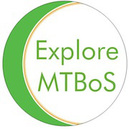Here are the books I either read for the first time or reread this year:
- Embedding Formative Assessment: Practical Techniques for K-12 Classrooms by Wiliam and Leahy
-I would definitely recommend this book! It's very much worth the read. - The Formative 5: Everyday Assessment Techniques for Every Math Classroom by Fennel, Kobett, and Wray.
-I'm still undecided on this one. I found it helpful and frustrating at the same time. On the one hand it helped expand my ideas about what I can use as assessment in my classroom. On the other hand it was frustrating because it advocated collecting all the data coming in but the sheer scope of the data was overwhelming. On top of that, it did nothing to give ideas on how one could go about quickly collecting and organizing the data. - 5 Practices for Orchestrating Productive Mathematics Discussions by Smith and Stein
-Oh. My. Goodness. This book changed how I teach. This year was my 3rd time through the book. It's that good. - Principles to Actions: Ensuring Mathematical Success for All by National Council of Teachers of Mathematics
-This book is a great reminder about what best practice looks like in the classroom. Well written and backed by research. Every other sentence has a footnote. I'd recommend reading it with a group of people. It was hard to do on my own. - Implementing the Common Core State Standards through Mathematical Problem Solving by Gurl, Artzt, and Sultan
-I wouldn't recommend this book. I appreciated the effort and the concept but the execution of the book left me wanting more. Maybe it's that I expected better problems. It felt like going through the harder problems in each section of a textbook. It was okay but it doesn't really come close to the things the Math Assessment Project, Open Middle, Visual Patterns, *insert 4 or 5 more excellent resources here*, are doing. - Teaching Math with Google Apps: 50 G suite Activities by Keeler and Herrington
-I appreciated the effort but I didn't get into the book. There's some good pointers in here, but nothing earth shattering. I guess that makes sense--there's only so much Google Apps can do. Since I'm not an early adopter of technology (I'm more of a 'wiling to be convinced' person) I'm probably not really the intended audience for the book. So, take this with a couple of grains of salt.
I haven’t quite finished everything that I want to. Here’s the list of books I’d still like to read:
- I’m currently in the middle of Leaders of Their Own Learning: Transforming Schools Through Student-Engaged Assessment by Berger, Rugen, and Woodfin
- Differentiated Assessment and Grading by Wormeli
- How to Grade for Learning: K-12 by O’Connor
I started off working through Wiliam and Leahy’s book during endless elementary soccer practices. It was so good it pretty much served as the basis for my plan for the year. I made a list of tools I wanted to implement and then would try out one or two new ‘tools’ every month to try to cement them into my regular classroom practices. Once I got deeper into the other books, there was a little more conflict about what types of tools were best and how or if to collect data (preview of upcoming Wiliam vs Fennel cage match!). Early on in the year, it was all just figuring out how to turn ideas into actual boots-on-the-ground-daily-routines in my classroom. Trying to change deeply embedded ways of doing things made me feel like a new teacher--all awkward and self-conscious in ways I haven't felt in years.
Here's a quote I loved from my reading:
“Teachers are frequently told what they should do, but they are usually not provided clear guidance on how to implement it in their classrooms--theory triumphs over practice” (Fennell et al, xiii).
Of the 5 areas involving formative assessment (below) I spent the majority of my year with the first two. I dabbled a bit in the others, but didn’t really have a lot of success with them.
- Clarify and sharing learning intentions and criteria for success with students.
- Engineering effective classroom discussions, questions, and learning tasks that elicit evidence of students’ learning.
- Providing feedback that moves learners forward.
- Activating students as owners of their own learning.
- Activating students as instructional resources for one another. (Wiliam and Leahy, 11; Fennell et al 7)
For the purposes of this post, I only want to talk about the first one: “Clarify and sharing learning intentions and criteria for success with students.” In normal person language, I think it’s roughly translated as: ‘What do I want my students to learn?’ and ‘Do students know what I expect them to learn?’.
I started out each unit by breaking the unit into standards which I would cover in the lessons/activities. I did this for almost the entire year *self-congratulatory pat on the back*. I then posted learning targets at the beginning of every lesson… for a couple of months. Like the first time you do anything, there are so many things I would do differently. I stopped posting learning targets at the beginning of the lessons because I felt like it didn’t make any difference to my students--at all. Actually, that’s not true; I thought it was worse than what I was doing before. The way I implemented it, it felt like something for my students to copy down and we never talked about it again. I realize now that students didn’t take ownership because I never made it a point to circle back to the standards at the end of the unit or even had them self-asses the standards as we went along. It’s obvious in retrospect but I only figured this out the week before Spring Break.
Next year, with a couple of small-scale tweaks, I think I can get more buy in from everyone involved. I need my assignments and my assessments to consistently circle back to the learning targets. If I don’t take time to show how important they are to me then students won’t think they are important either. I’m thinking about starting with tests/quizzes and the review material leading up to tests/quizzes. Every test and quiz question could be linked to a standard. That way, when students need to do retakes they know what they need to study and I have a better idea about the types of interventions I need to make. Better yet, if my review assignments were linked to each of the standards, the students would be able to self-assess the standard and ask better questions. I said small-scale tweaks but we are talking about rewriting every test and quiz I give. Maybe I need to jump in both feet with one class rather than trying all of them at once.
Some of you are probably shaking your heads slowly and queueing up multiple posts you’ve written on standards-based grading. Here’s where it’s probably worth mentioning that I basically did contortions to not do standards-based grading this year. Like an idiot. I was trying to follow the road marked out by my books. Different authors had very different views on collecting and organizing student data. The way I understood Wiliam and Leahy’s advice was to not take down data about individual students. The point of formative assessment was to get a pulse on how the class was doing and to pinpoint individual help for either day of or next day interventions. If individual students had issues, you could address those issues over the next couple of days but there wasn’t any point in keeping information past a couple of days because the problem would have been addressed. Initially, it the system worked fine for me. But then, after a month or so, I wanted to circle back to issues students were having to make sure things were really okay. For the life of me, I couldn’t remember. Sometimes I remembered the students but I didn’t know what the exact issues were anymore. Other times, I remembered the misconceptions but was fuzzy on which particular student had them. Not helpful. I probably misunderstood the book.
Pretty much, I think fate has my road marked to try some modified form of standards-based grading next year in one of my classes.
My next post will start detailing some of the particular formative assessment tools I tried.
 RSS Feed
RSS Feed



